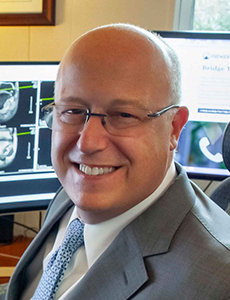Sponsored Content by One Call
How Teleradiology and Artificial Intelligence Are Reducing the Strain of the Radiology Shortage on Workers’ Comp

Diagnostic imaging has experienced a boom in recent years.
More than 70 million CT scans are performed in the U.S. each year, according to the National Institutes of Health. That number is up from just three million in 1980. The number of MRIs, too, has increased, and the U.S. conducts more scans than any other country, per researchers from Stanford University and Mayo Clinic.
The reason for the increase? The quality of scans has improved, allowing radiologists to more accurately detect fractures, tears, and sprains. As technology has improved, the cost of scans has dropped, allowing more patients — especially those in workers’ compensation — to access the technology. In the past, workers’ comp payers may have discouraged imaging due to its high cost. Now, they encourage it because its low cost and high quality allows them to detect what’s actually happening with their injured worker – which includes insight into the age of an injury – ensuring the most appropriate treatment plan is in place to expedite recovery.
Though demand for imaging has increased, the number of radiologists in the country has simultaneously waned. The nation could face a shortage of as many as 35,600 radiologists and other specialists by next year, per a 2021 report from the Association of American Medical Colleges. The reasons for the shortage are varied. A large number of radiologists are reaching retirement age, and fewer medical students are going into the specialty. Other students may forgo medical school, in general, due to the high cost.
“A lot of doctors are not necessarily going into radiology anymore,” said Dr. Jonathan Luchs, FACR, chief medical officer for Premier Radiology Services and head of One Call’s Radiology Advisory Board.
“And less people are going into medicine because of the cost of the schooling, the time it takes, and the cost-benefit analysis when it comes to what you’re really going to make when you come out, depending on the specialty you go into.”
The shortage, coupled with the increased demand for medical imaging, means that practicing radiologists have to read more images in a day than they are used to, on top of completing administrative tasks like dictating reports. A longtime scourge on the medical field, burnout from overwork is causing many physicians to exit medicine altogether, and radiology isn’t immune to that trend.
For workers’ comp, a shortage of radiologists means it might take days for an injured worker’s MRI or other imaging services to be evaluated. And, injured workers often have injuries like strains, sprains, and other musculoskeletal injuries that are of lower acuity than other, more dangerous conditions.
“An injured worker’s MRI or X-ray may not be at the top of the priority list when it comes to the type of injury. These patients could have a rotator cuff tear or a herniated disk. People who have an acute fracture, acute appendicitis, or things like that wind up going to the top of the list, and the injured worker starts moving to the bottom,” Luchs said. “It could sometimes be a day or two until the MRI or the X-ray is read.”
To help combat the radiologist shortage and ensure injured workers’ images are evaluated in a timely manner, many in the industry are turning toward tools like teleradiology and artificial intelligence (AI). These tools increase the number of potential radiologists available to read an injured worker’s scan, and they help radiologists evaluate more images per day.
The Role of Teleradiology in Reducing Talent Shortage

Dr. Jonathan Luchs, FACR, Chief Medical Officer for Premier Radiology Services and head of One Call’s Radiology Advisory Board
Teleradiology is the practice of virtually sharing CT scans, X-rays, and MRIs with radiologists for evaluation so that a physician, perhaps with a specialized focus on a particular injury, can evaluate a scan regardless of where they’re located.
The practice widens the pool of potential radiologists available to read an injured worker’s scan, reducing the effects of the talent shortage. Rather than waiting for a local radiologist, a physician in Florida can read a scan from a patient in New York, so long as they hold a license in the state they reside, as well as the state where the imaging study was performed.
“Teleradiology is a great way to really expand the group of radiologists who partner with you,” Luchs said. “It improves patient care because patients wind up getting their studies read in a timely fashion, which is within 24 hours.”
Beyond expanding the number of radiologists available to read a scan, this approach allows injured workers to have their imaging read by a subspecialized radiologist who may focus on a specific body part. A radiologist three states away might specialize in reading shoulder scans; another might have a passion for ankle fractures or wrist injuries.
“It allows you to access to a larger set of subspecialties that you may not have in a smaller group,” Luchs said.
By providing scans to subspecialists who love evaluating particular types of injuries, teleradiology can also help reduce burnout among practitioners. Radiologists with extensive knowledge of a particular body part are often better at recognizing particular injuries and can assess scans more efficiently.
“By giving radiologists studies they enjoy reading, they’re going to be less likely to burn out,” Luchs said.
How AI Can Help Address Radiology Shortages and Improve Patient Outcomes

Darren Barr, Vice President of Product Development, One Call
In addition to using teleradiology to expand the number of physicians available to read a scan, radiologists are using AI to flag injuries and enhance workflows, increasing the number of scans they can read in a day and ultimately, improving patient outcomes.
“A radiologist who doesn’t use AI is going to be replaced by the radiologist who does,” Luchs said.
One way AI is being utilized in the industry is through computer-assisted diagnostics. In this process, AI is trained to recognize injuries on various imaging studies, then it flags scans for injuries. Radiologists review the AI results, which helps them create the most accurate and timely report.
AI also assists in triaging imaging studies by prioritizing scans that need immediate evaluation. If an injured worker has a broken bone, for instance, but the referring physician doesn’t flag it for immediate review, a radiologist might think the scan is a lower priority. AI ensures it gets looked at right away.
“If AI says there’s a fracture on a patient, it automatically gets moved to the top of the list and becomes a stat AI read,” Luchs said.
From alleviating administrative burden to assisting in interpretations, AI continues to make a meaningful impact on the radiology industry.
By incorporating teleradiology and artificial intelligence, radiologists can streamline their workflows, allowing them to evaluate more scans in a given day with increased accuracy, reducing the strain of the talent shortage.
“As an industry, it’s important we continue talking about ways to manage the ongoing radiologist shortage while improving workflows,” said Darren Barr, vice president of product development for One Call. “It’s all about creating the most accurate, effective, and timely recovery plan possible for the injured worker.”
Using New Radiology Technologies to Drive Better Outcomes for Injured Workers
As a leader in the diagnostic space for workers’ compensation, One Call has played a key role in ensuring injured workers are able to have their scans completed at the most appropriate center and then read in a timely manner.
The organization has partnered with Premier Radiology to access their industry expertise and specialty services from a variety of U.S.-based radiologists who have experience working with injured workers.
“We saw a good opportunity to partner with Premier Radiology to enhance our Radiology Advisory Board,” Barr said. “By partnering with Premier, we have access to top radiologists when we need them.”
One Call, along with its Radiology Advisory Board, plays a key role in educating clients and other industry professionals about new tools and best practices in an ever-changing radiology landscape.
“We continue to build tools that automate, enhance, and alleviate administrative burden,” Barr said. “We’re refining our provider selection criteria and building direct connectivity with our network locations to help ensure we’re utilizing the best possible facilities.”
The result: More injured workers can have an accurate diagnosis without significant delays, moving them down the road to recovery faster and more effectively. By leveraging best practices, many radiology centers can continue to provide strong outcomes despite an ongoing radiologist shortage.
“How are you going to really put the patient down a targeted directive of care unless you know exactly what’s wrong with them?” Luchs said. “With access to the proper diagnostics solutions early on, the worker can get treated exactly how they should be treated from the get-go.”
To learn more, visit: https://onecallcm.com/.
This article was produced by the R&I Brand Studio, a unit of the advertising department of Risk & Insurance, in collaboration with One Call. The editorial staff of Risk & Insurance had no role in its preparation.









